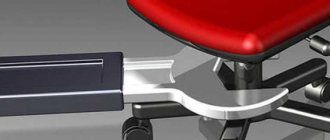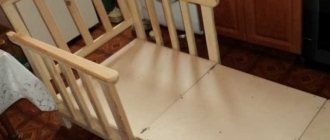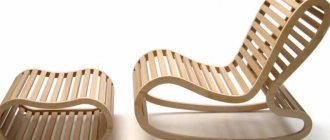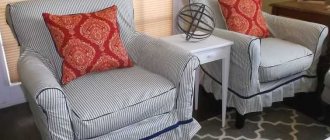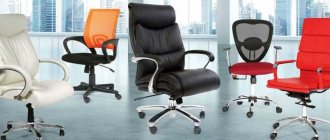19812
A computer chair is an indispensable attribute of a modern office, study or workspace in the home. It is comfortable, versatile - adapted to different parameters and weights. The chair holds the back well, fixes posture, which makes a person less tired and reduces the load on the musculoskeletal system. Despite its reliability, the chair sometimes breaks, which causes inconvenience. One of the most common breakdowns is damage to the wheels. That is why you need to know how to remove the wheels from an office chair and replace them if necessary. Such repairs do not require special knowledge or high costs - you can do it yourself without calling a specialist.
Design features of a computer chair
Repairing an office chair with your own hands requires some knowledge. There are many features to consider when purchasing furniture. You should not buy products where the manufacturer does not provide a warranty of at least one and a half years. Otherwise, you will have to constantly repair the product, which will cause significant difficulties.
One of the most common causes of failure is the gas lift, as the part that is most susceptible to wear.
Structurally, the product consists of several elements: a back, a seat, a cross part with rollers for moving on the floor. If any of these components fail, the chair cannot be used. It is necessary to repair the damage in order to continue to use the furniture normally.
If you are faced with a malfunction of your computer chair, you need to find out which part requires repair.
The product includes the following components:
Piastra. Made from high quality metal. This element is made in the form of a lever. Used to change the height of the seat relative to other components. Rollers. Depending on the manufacturer, they may consist of metal or plastic. The first option is more preferable, as it has high performance properties. The hinge mount is made of metal. It connects to the main structure to allow movement on a smooth floor surface. Base. It can be metal or plastic. The first option is more preferable, as it has high strength and reliability compared to plastic. The latter breaks down faster under the influence of high physical stress. Permanent contact. It is a connecting component. Used to attach the seat and backrest. Allows you to change the position of the backrest relative to the vertical. Rocking mechanism. Responsible for deviations and fixation of the seat in one position. More expensive models are equipped with complex mechanisms that provide more stable fixation and smooth rocking when leaning on the back of the seat. Gas elevator
This detail is important for a computer chair. Responsible for elasticity
When a part breaks, this property is reduced, causing discomfort to the owner.
Parts may be required for replacement. They can be purchased in specialized stores. You can also purchase spare parts on the manufacturer's official website. It is for this reason that it is recommended to buy only furniture from trusted companies. This makes it possible to repair the product at minimal cost, using available materials and simple tools that are found in every home.
Before you begin repairing a computer chair, experts recommend carefully studying the types and design features of such products.
Publications
Chair mechanisms
The price of an office chair depends both on its external qualities and on its technical parameters. The upholstery of the chair greatly influences the price; it can be made of different materials, ranging from simple fabric to high-quality leather. But still, most of the cost of the chair is its mechanisms. Let's talk about them.
Different companies make different mechanisms for their chairs, but they are all similar and some are unified to international standards. Let's start with the simplest one, which is used for inexpensive chairs.
1. Piastra
The unit connecting the gas lift rod to the base of the operator's chair seat. The piastra is equipped with a gas lift adjustment lever. In the production of piastres, welding of the gas-lift fastening coupling along the entire contour and an iron sheet of increased thickness are used. Attached to an office chair using four bolts. There are also holes on the pistre for attaching the back of the chair, and various mechanisms can be used for connection:
| Spring-screw mechanism for constant back support - there is a spring under the plastic “knob”. And when twisted, it contracts, imparting rigidity to the tilt of the back, or vice versa, making the tilt easier. | Ovalina - serves to connect the back and seat of the chair, often allowing you to adjust the height and depth of the back. | Permanent contact - serves to connect the back and seat of the chair, allows you to change the angle and height of the backrest |
2. TOP GAN swing mechanism (DMS)
Functions: adjusts the chair height and allows the office chair to swing. The mechanism allows the chair to be fixed in a vertical position while swinging; some more expensive models allow it to be fixed in the maximum reclined position, mainly on executive chairs.
The mechanism that locks the chair in the working position has three adjustments.
- The chair is adjustable up and down using a lever that acts on the gas lift (on some models of chairs, instead of a lever, a “button” is used to adjust the height)
- The same lever, when adjusted to the right or left, allows you to “turn on the swing mechanism” or fix the chair in the working position (i.e. with a vertical backrest). In some models, this function is performed by an additional lever.
- The spring allows you to adjust the rigidity of the swing according to the weight of the person sitting.
This mechanism can be divided into two types.
- Central-axis - the swing axis is located directly in the center of the seat; when the chair is fully tilted, the sitting person’s legs come off the floor, which is not a positive point. This mechanism is mainly used on inexpensive executive chairs and staff chairs.
- A mechanism with an offset center - the swing axis of the chair is shifted to the front of the seat, even with the chair fully tilted, the legs of the seated person do not come off the floor, thereby not interrupting the blood flow to the legs. This mechanism is mainly used in executive chairs and much less often in employee chairs.
3. Multiblock
A more modern mechanism allows not only to adjust the height of the chair, but also provides the ability to rock the chair and also fix it in several positions.
Typically, a lever located on the right under the seat of the chair is responsible for adjusting the height, and a lever located under the seat on the left is responsible for turning on the swing mechanism and fixing the chair; the screw that regulates the swing force is often located in the front center of the chair.
A distinctive feature of this mechanism is the anti-shock effect, it lies in the fact that when the lock is removed, the position of the backrest remains unchanged, however, when force is applied to the backrest, it reclines slightly, which makes it possible to avoid a blow from the backrest when the lock is removed or a sudden “ deviations of the backrest.
At the moment, there are many modifications of this mechanism, for example, a synchronized mechanism - It allows you to change the angles of inclination of both the back of the chair and the seat simultaneously, with a certain dependence. The optimal “ergonomic” proportion for a synchronous change in the angle of the backrest and seat is considered to be a 3:1 ratio, in which a backrest tilt of 3° corresponds to a seat tilt of 1°. The backrest tilt range is usually 30-36°. The backrest anti-return system prevents spontaneous changes in tilt angles, and as a result, the user does not make any effort to hold the chair in a certain position.
Depending on the degree of complexity, synchronizing mechanisms can have different ways of fixing the position of the chair - fixing it in any position or only in a few specific positions. The design of the mechanism completely eliminates the possibility of the chair tipping over. All synchronizing mechanisms are necessarily equipped with load adjustment to adjust according to the user’s weight.
And of course, no office chair can do without standard elements.
4. A chair gas lift, also known as a gas cartridge, is designed to adjust the height of an office chair.
The gas cartridge cannot be used at temperatures below 5 degrees. At low temperatures it freezes, and under load it will simply fail immediately. If an office chair was purchased during the cold season, then it only needs to be assembled after 24 hours. The permissible load on the gas lift is 100 kg. This does not mean that with a load of 120 kg it will immediately break. No, it’s just that the service life of the gas lift will be an order of magnitude shorter.
Its operating principle is quite simple: in a metal tube there is a cylinder under high pressure, which constantly presses on the piston and it, in turn, goes down, thereby lifting the tube itself up. How does it work in a chair? You pull the lever, which presses on the button that regulates the flow of gas into the cylinder, and the pressure cylinder lifts the chair up. Of course, it only has enough power to lift a chair without a person sitting on it. And when lowering the chair, we must already sit on it, and then the piston under pressure goes up and the tube goes down. By releasing the lever, we stop the transfer of gas from the tubes and the chair stops at the selected height. It is necessary to mention such an important part of the gas lift - the bearing, which allows the piston and cylinder to rotate around its axis, thanks to which the office chair can rotate around its axis. A large iron body serves to support the stem in the correct vertical position.
There are three main standard sizes of gas lift - short - for executive chairs (piston stroke 85-100mm), medium - for operator chairs (piston stroke 120-140mm), and high - for bar or children's chairs (piston stroke 240-260mm). However, all gas lifts have standard seating dimensions and are interchangeable (if the change in chair height suits you). The gas lift body can be painted black or covered with chrome; gas lifts painted in other colors are rarely found, which is due to the imagination of the designers and does not affect functionality in any way.
PS Be careful, the gas cartridge itself (this is usually a shiny rod) contains gas under high pressure! Damage to it should be avoided. It is not recommended to open it!
5. The crosspiece (also known as the five-beam) is an indispensable part of a modern chair; it not only serves as a reliable support for the entire chair, but also allows you to make the workplace “mobile”, allowing you to move around the office without getting up from your chair.
There is a wide variety of crosses both in appearance and design features. They can be made of plastic, glass-filled polyamide, metal, aluminum, wood, as well as iron with wooden overlays.
Despite all the diversity, almost all crosspieces can be interchangeable, since the seating dimensions for the gas cartridge and wheels are accepted the same all over the world, and the choice of one or another crosspiece is often determined by design ideas, less often by the requirements of engineers for the ergonomics of the chair.
6. WHEELS are the smallest part of the chair, but not the least important in terms of importance and functionality; thanks to the wheel supports, you can move a certain distance without getting up from the chair.
Kinds
The main rule is that on a hard floor the wheels should be soft and vice versa. Otherwise, there will be either scratches on the coating or great effort when rolling. Therefore, you need to choose the right roller material.
Material
Plastic. The most inexpensive and installed on most chairs. They are suitable for carpets as they do not leave marks on them. Parquet can be scratched, and thin linoleum can be pressed through.
Silicone. Well suited for uneven floors. They do not leave marks on parquet and laminate flooring and allow you to avoid noticing joints. The strength of such wheels is lower than polyurethane ones.
Rubber. Similar to silicone, but may leave dark streaks on varnished floors. Not suitable for sterile environments.
Polyurethane. High strength is combined with an attractive appearance and an abundance of colors. They have proven themselves well on all types of coatings. They are resistant to aggressive influences, which allows them to be used not only at home or in the office.
In addition to the material, there are differences in the design of the rollers.
Design
The design of the wheels should match the style of the chair, so different models have their own options.
Office. They can be open or protected by a skirt that prevents wires from getting into the wheel. The latter option is more beautiful and safer, but it is more difficult to maintain. Often wheels are rubberized - this is when a rubber tire is put on a plastic hub. This increases comfort and the wheels run silently.
Gaming or gaming. They are stylized to resemble the rims of cars and motorcycles and are painted accordingly. Some are very similar to roller wheels and have spokes, others differ from office wheels only in the pattern. You need to be careful with them, because if a foreign object gets into the knitting needles while moving, there may be unpleasant consequences.
Wheels with locks. They have a rotation locking mechanism, which in theory allows you to lock the chair in one position. In practice, the chair can slide on the floor. Yes, and you need to fix all 5 wheels, which is not very convenient. Fortunately, the lever can be pressed with your foot.
Additional Tips
The task becomes even easier if it disappears on its own. Excess parts can be pulled out using a screwdriver; they will no longer be suitable for any purpose. Experts advise making a complete replacement, since different types of wheels can make it difficult to move on the floor covering. And in general, timely replacement will ensure a longer service life of the rollers.
This information on how to change wheels on office chairs will also help if you had to assemble a new model yourself and without instructions.
Source
How to remove wheels from an office chair
For those who have held a screwdriver in their hands at least once in their life, disassembling the wheel of this office furniture will not be difficult:
- First, purchase a new wheel from a specialized store. As a rule, they all come in standard sizes. Manufacturers do everything possible to ensure the convenience of their customers.
- If the fastening is not clogged or rusted, then you can pull the structure out of the groove with your bare hands. If the wheel does not budge and you need to apply more force, use a flat screwdriver or chisel.
- Simply pry the metal pin of the broken part at the entrance to the groove. Use the screwdriver as leverage to push the broken wheel towards you. There is no way to reuse it, so don’t be afraid to use extra force.
- If necessary, remove dirt and wipe the mechanism.
- Insert the new wheel into the notch. As a rule, there is no need to secure it in any way. The design involves a small groove on the wheel axle. When placing it in the holder, the gutter fits into a special protrusion and is securely fixed. Just press the wheel until it clicks.
No one guarantees the identical functioning of parts from different manufacturers. Not only can this lead to rapid wear of the remaining wheels, but the structure of the chair itself can be seriously damaged. Buying a new chair for yourself is quite expensive.
Procedure
A standard office chair is not a complex mechanism, especially when it comes to wheels. Removing them will not be difficult, and you don’t even need any available tools. The thing is that they are simply inserted into specially made holes in the crosspiece and secured with a small click.
You can fasten them yourself, by hand. The main thing is to put in a little effort so that they do not break again during use.
It is most convenient to do this with a disassembled cross, then the top of the product will not interfere with a tight fit. But even with this approach, completely replacing all the rollers will take you no more than fifteen minutes. This suggests that there is no point in turning to someone for help; even a fragile woman can cope with this task. The advantage is that you don’t need a lot of knowledge to understand how to disassemble the wheels of an office chair.
Breakdowns and ways to fix them
Even the best quality rollers break over time. But thanks to the simplicity of the chair’s design, the vast majority of breakdowns can be repaired yourself. In this case, you do not need to be a top-class specialist or have a special tool - you can remove and install the wheels by hand.
But before repairing, you should find out the causes of the malfunction.
- The wheels don't spin well. This is probably due to the fact that foreign objects, stripes or threads got into them. In this case, you need to clean them of debris and then lubricate them with WD-40 or I-20A. For cleaning, use something like a knitting needle or scissors.
- Cracks on the wheel. In this case, the part must be replaced, since the glue will not provide the required strength. Most likely, this is due to a long service life or a manufacturing defect.
- Noise when torsioning. The roller needs to be lubricated. It is better not to delay this, since “oil starvation” increases wear and reduces service life.
- The roller is rocking. This may indicate wear on the plug on the cross where the rod is inserted. In this case, the plug and wheel must be replaced.
In what cases is it necessary
Before studying the question of how to remove a wheel from a computer chair, you need to find out the nature of the malfunction. Roller failures come in several forms:
- the wheel stops rotating;
- scratches the floor surface;
- falls out of the mount.
The reasons why the casters on an office chair are damaged can be different:
- contamination - dust, dirt, threads, hair, falling on the wheel, clog it, interfere with proper functioning, which leads to premature wear;
- heavy weight - constant loads contribute to breakage of small parts, fasteners, including the wheel;
- mechanical damage – careless use often leads to malfunctions;
- unevenness on the floor - due to prolonged use of the chair in such conditions, the socket becomes loose;
- wear and tear – the lifespan of a computer chair is limited; over time, parts wear out and require replacement;
- manufacturing defects.
Regularly cleaning them from dirt and foreign objects will help prolong the life of your wheels. Thanks to such procedures, the rollers will be able to move freely without feeling any obstacles. Replacing broken parts is always easier and cheaper than buying a new chair - they are available and easy to install.
For carpeted floors, it is recommended to choose a chair with smooth wheels; for slippery surfaces, it is advisable to use rubberized casters.
Features and Requirements
The peculiarity of furniture is that the more comfortable and durable it is, the heavier it is. To maintain mobility, you need wheels, which have a number of requirements.
- Strength. Not only durability, but also safety depends on this. If the wheel suddenly breaks, the chair will tilt and you may fall.
- Durability. Wheels must withstand significant loads over long periods of time. Ideally, the entire life of the chair.
- Comfort. Joints are possible on the floor surface, and soft wheels absorb small impacts better.
- Ease of rotation. The chair should save energy and not turn into a simulator. This parameter depends not only on the quality of the wheels themselves, but also on the correct choice.
- Aesthetic pleasure. The rollers on gaming chairs can be stylized to look like car rims.
How to independently disassemble the wheels of a computer chair to clean it from rubbish, screw it up. on the bushings?
How to independently disassemble the wheels of a computer chair to clean them from junk that is screwed onto the bushings?
It is believed that most office (computer) chair wheels are not collapsible, i.e. - unrepairable due to the fact that the wheel is mounted on the axle with such a tight tension that one careless movement and the wheel will have to be thrown away. But this is not entirely true; nevertheless, sometimes it is possible to disassemble them if you work carefully.
I’m not speaking out of nowhere, not very long ago I also had to worry about this problem - several wheels did not spin, but literally rolled on the floor. An attempt to remove accumulated dirt (lint from the carpet, hair mixed with small debris) using tweezers did not yield any results.
After scouring the Internet, I managed to find this video, where a young man confidently, with a minimal set of tools, easily disassembles, cleans and reassembles them.
Of course, I didn’t have such clever “toothy” scissors, so I worked with duckbill pliers with long thin jaws. Something like this:
Selection rules
Once you decide on a design, there are a few things you need to know.
The possibility of installing wheels is determined by the dimensions of the landing rod. It may vary among different manufacturers. For Russian ones, the diameter is usually 10 mm and the length is 20 mm. For foreign companies, the diameter is usually 11 mm and the length is 30 mm.
This means that before purchasing a set of wheels, you need to measure these dimensions with a caliper. Or, as an option, take an old video with you and choose according to the sample.
Make sure there is a stopper on the rod. It is this part that fixes the roller in the cross
Some rollers are equipped with a threaded rod and nut. When choosing, make sure that the diameter and thread pitch match.
You can also select the diameter of the roller itself. Usually it is 37-50 mm. The larger the wheel, the better it rolls and overcomes bumps, but the more cumbersome it is.
Some wheels (mostly furniture ones) are equipped with a plate instead of a rod. If necessary, the plate can be replaced with a rod and vice versa.
Before buying a set of wheels, it is better to find the reason why the old ones failed. This will either prevent you from repeating mistakes or not be too upset about a breakdown.
"Piastra" and "Spring-screw mechanism"
Fig 1 - Piastra. Hole for gas lift (buy piastres). Fig 2 - Handle for adjusting the chair height.
Piastra is the simplest mechanism that works only up and down, by adjusting the handle where the gas lift valve is pressed. Installed mainly on cheap models of chairs.
This is what the piastre looks like from the bottom of the chair:
Catalog section:
All chairs with PIASTRE mechanism
Examples of chairs with a piastre mechanism:
Many inexpensive chairs also have a spring-screw mechanism for constant back support. There is a spring under the plastic “knob”. And when twisted, it contracts, imparting rigidity to the tilt of the back, or vice versa, making the tilt easier. (Fig. 3). It allows you to relieve your back a little.
In staff chairs, like the Prestige model, the spring-screw mechanism works differently. There are three screws, when tightened, it becomes possible to adjust the height of the backrest (red arrow), the deviation of the backrest (blue arrow) and the distance from the seat (green) (Fig. 4). But everywhere the work happens with the help of a spring.
Fig.3 Fig.4
Examples of chairs with a spring-screw mechanism:
"Jupiter" chairman 9801pl "Focus GTP"
Why do the wheels on a chair break?
There may be several reasons for this:
Wrong chair
When purchasing a chair, be sure to pay attention to the maximum weight that the chair can support. Otherwise, you will soon receive an unpleasant surprise in the form of a breakdown.
Manufacturing defects
This scenario cannot be ruled out. In such cases, the seller always provides a guarantee for his product. If the product breaks down while the warranty card is valid, your money will be returned or the chair will be replaced with a new one. The main thing is to follow all operating rules so as not to cause wear of initially high-quality parts. Uneven floor. Because of this, the load on different wheels will differ from the standard one. Consequently, it will lead to their rapid wear. Dirty room. If the office is rarely cleaned, then a large amount of garbage accumulates on the floor. Dust, dirt, and hair can cover or simply wrap around the moving mechanisms of the wheel and prevent the mechanism from performing its direct function. Normal wear and tear has not been canceled either. Like any other part, wheels have their own service life. This is a natural process. So just buy a new wheel and replace the broken one.
In order for your “colleague” to serve for a long time and not disappoint with unpleasant incidents, choose the right model correctly. And also make sure that the load during the working day is evenly distributed across all the wheels in the system. Keep your work area clean. And don’t forget to carry out preventive cleanings if necessary. After all, it’s easier to prevent another breakdown than to repair a chair.
Why do wheels sometimes break?
Of course, the two main reasons why wheelchairs on wheels break are a manufacturing defect or a worn-out landing pin. But this only applies to those cases when the chair is quite new and is even under warranty. But if the furniture began to work poorly after some time, then the first reason for such a breakdown is contamination inside the wheel structure. This includes dust, debris, hair, animal hair, and even carpet lint. They clog moving parts, thereby reducing the service life of components.
Naturally, the first thing you will notice is the inability to remove the wheel from the chair and clean it from the inside. Some structures are truly permanent, so they will have to be completely replaced. If the furniture can be disassembled, then even a teenager can handle cleaning the wheels.
Sequence of installation of new parts
After you have disassembled the office chair wheel, you can begin to inspect and possibly replace the broken elements. The option for repair and installation of new parts depends on the nature of the failure:
- The rollers do not rotate. Possible cause: contamination. The chair is turned over, the wheels are detached and inspected. If there is dirt and dust, they are cleaned with a brush or scissors (if they are wrapped in hair or thread). After you have managed to clean the wheels, they need to be washed and dried. Dry rollers are installed in place.
- The wheel falls out. Malfunction – the plug (the socket in the cross that secures the roller) is worn out. It needs to be replaced. To do this, the wheels are separated and the plastic protective covers are removed. Then, using a screwdriver, the plugs are pulled out. New sockets are installed, housings and rollers are returned to their place.
- Wheel damage. The roller itself or the locking ring, which is located on the axis of the landing pin, has broken. Thanks to this detail, the rollers are springy. Many people do not know how to change wheels. There is nothing complicated about this. The broken part is disconnected, the socket is inspected for damage and foreign objects, and a new wheel is installed.
In addition to damage to the rollers, other damage to the computer chair will occur:
- Gas lift malfunction. This is a detail that is responsible for a person’s comfortable position while working. With its help, the chair takes the desired height and backrest position. If the gas lift is broken, the seat does not rise, falls strongly or skews to one side. There are two ways to repair the chair - replacing or fixing the gas lift in one position.
- Broken crosspiece. This chair is quite durable, but if it breaks, the only way is to change it. Metal crosspieces are more durable and expensive, plastic ones are lighter and more affordable.
- Backrest malfunction. If the backrest does not lock in the desired position and hangs, then it needs to be changed. If the permanent contact handle, which secures the backrest, does not work, it is advisable to replace the permanent contact.
Damaged computer chair wheels cause a lot of inconvenience. Finding out the cause of the breakdown and eliminating it is easy and simple. This does not require special knowledge or professional tools. You can do the repair yourself, without the help of a specialist. This will save time and money.
How to disassemble a chair wheel to clean it
Typically, the design of chairs on wheels does not differ from each other. You don't need any special tool or special skills to remove them. All moving elements are attached to special grooves that are drilled in the crosspiece. The parsing mechanism is as follows:
- Pull the wheel a little and pull it out of the hole in the crosspiece of the chair;
- separate the roller itself from the protective plastic;
- If the plugs are broken or worn out, they will have to be replaced with new ones.
Now you can start cleaning the wheels. If they are heavily soiled, remove as much accumulated debris as possible. You can use scissors or a knife, but you need to act very carefully so as not to scratch the wheel itself. Some owners have found a more effective way - a sewing tool for steaming seams or needle-nose pliers. They themselves are quite narrow, which helps to reach the most inaccessible places in the wheel structure.
Once all the twisted debris has been removed, you can additionally vacuum the wheels to remove as much dust and small hair as possible, and only then proceed to washing.
Washing chair wheels does not mean anything unusual. It is enough to wash them in soapy water, rinse and dry well.
There is one very important point in this whole process: before sending the rollers into place and assembling the entire structure as a whole, all parts must be dried very well. Otherwise, mold, mildew and even rust may form from excess moisture.
Causes of office chair breakdowns
Before you begin making repairs yourself, you must:
- understand the design of a piece of furniture;
- find out which element is faulty.
Computer chair design
The main components of an office chair are:
- seat and back;
- permanent - a contact connecting the backrest to the seat and allowing you to adjust the angle of inclination;
- armrests;
- piastra - the mechanism by which the chair is controlled;
- gas lift providing seat height adjustment;
- cross with rollers, acting as support and moving mechanisms, respectively.
Main components of an office chair
To connect all parts, fastening screws with sufficient strength are used.
Definition and causes of malfunctions
The presence of malfunctions in the operation of a gas elevator (lift, gas cartridge) is indicated by the following aspects:
- the gas lift does not hold the seat in the specified position;
- the seat does not lower or rise when operating the control lever;
- the seat goes down under the own weight of the sitting person;
- the chair is tilted from its axis to one side;
- the chair “swings” in different directions.
Signs of a malfunction
The main reasons for the formation of these malfunctions are:
lack of lubrication in the mechanism. During the entire period of use, the gas lift requires periodic maintenance, which consists of applying lubricants;
For lubrication, you can use any ready-made compounds and/or oils.
Special composition for gas lift lubrication
- natural wear and tear. Manufacturers guarantee the operation of the mechanism for 18 – 24 months. After the specified period, it is necessary to carry out repair work or replace the main furniture units;
- improper operation: exceeding the permissible load level, jumping on the seat, and so on.
How and why do wheels break?
Computer chair wheels, although durable, still have some weaknesses.
The rollers, unlike the entire structure, are holders of the main weight, which rests on the entire product. Even ordinary dust can reduce their service life by clogging moving parts.
They can break and fall off for various reasons, but the main ones are:
- uneven surfaces on which they drive;
- exceeding the permissible weight for one product;
- mechanical damage;
- upon expiration of service life.
Naturally, it is not advisable to purchase a new chair just because of one caster, especially if a person is already accustomed to his workplace. And then the desire arises: I’ll take it apart and change these wheels myself! The main thing is to know how to remove the wheels from an office chair and then attach new ones.





